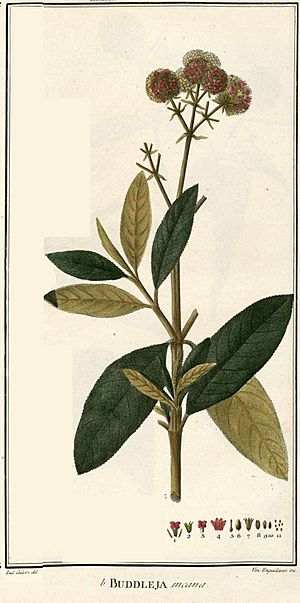Buddleja incana facts for kids
Quick facts for kids Buddleja incana |
|
|---|---|
 |
|
| Scientific classification | |
| Genus: |
Buddleja
|
| Species: |
incana
|
| Synonyms | |
|
|
Buddleja incana is a type of shrub or small tree. It belongs to the plant family called Scrophulariaceae. This plant is originally from the Andes mountains in South America.
Contents
What Does It Look Like?
Buddleja incana can grow quite tall, from about 4 to 15 meters (13 to 49 feet). Its trunk can be up to 50 centimeters (20 inches) wide at the bottom. The bark is brownish and has grooves.
Branches and Leaves
The branches are somewhat square-shaped and covered in soft, fuzzy hairs. They form a round top, like a crown. The leaves are tough and leathery. They are usually long and narrow, about 7 to 21 cm (3 to 8 inches) long and 1 to 5 cm (0.4 to 2 inches) wide. The top side of the leaves can be smooth or bumpy. The bottom side is covered in white or yellowish fuzzy hairs.
Flowers
The flowers are yellow to orange. They grow in clusters called panicles. Each cluster has many small flower heads, about 1 to 1.5 cm (0.4 to 0.6 inches) across. Each head has 15 to 40 tiny flowers. The petals of each flower are about 3 to 4 mm long.
Where Does It Grow?
Buddleja incana is found in several South American countries. These include Bolivia, Peru, Ecuador, and Colombia. It likes to grow in deep valleys along streams. You can find it at very high elevations, from about 2,700 to 4,500 meters (8,858 to 14,764 feet) above sea level.
What Is It Called?
This plant has different names depending on the local language.
- In Quechua, it is called kiswar.
- In Aymara, it is known as kiswara.
- In Spanish, people call it quishuar.
How Is It Used?
People in the Andes have used Buddleja incana in traditional medicine for a long time.
- The leaves are sometimes used to help with toothaches.
- They are also used as a diuretic, which means they help the body get rid of extra water.
See also
 In Spanish: Buddleja incana para niños
In Spanish: Buddleja incana para niños

